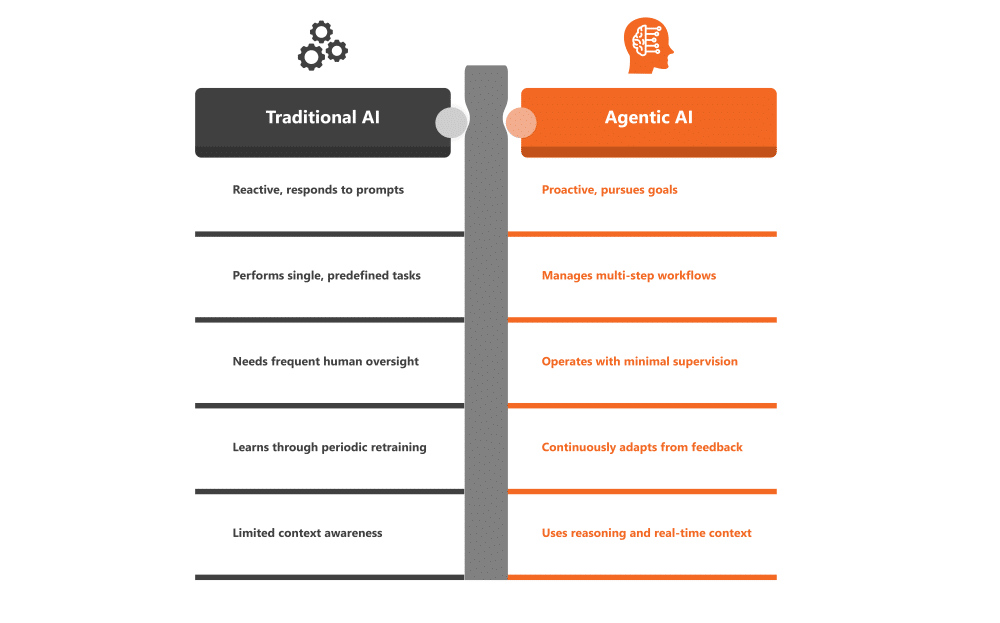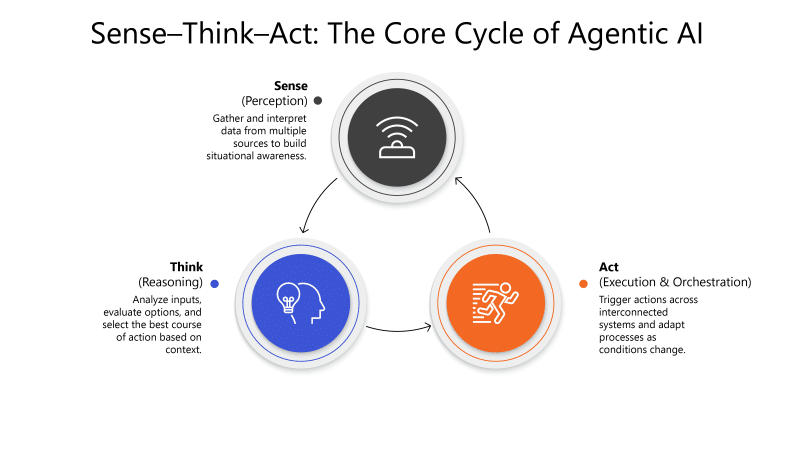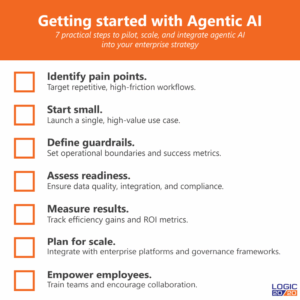Quick summary: Agentic AI represents the next stage of artificial intelligence, blending autonomous reasoning and action to drive strategic business outcomes while introducing new opportunities and challenges.
Artificial intelligence is entering a transformative phase with the rise of agentic AI: systems that don’t just respond to commands, but actively plan, reason, and execute tasks to achieve specific goals. Unlike earlier AI approaches focused on content generation or fixed automation, agentic AI enables organizations to optimize complex workflows with minimal oversight.
Adoption is gaining momentum. Nearly one-third of enterprises report experimenting with or deploying agentic AI, and almost half plan to adopt it within the next year. This acceleration reflects a growing recognition that agentic AI can drive efficiency, reduce costs, and unlock value in complex workflows that once required extensive human oversight.
In this article, we define what agentic AI is, explore how it is evolving, and share practical steps for integrating it into your enterprise strategy. We also examine its benefits—such as improved decision-making, cost savings, and operational agility—and the challenges organizations must address, including security, governance, and ethical oversight.
Article continues below.
PLAYBOOK
We will never sell your data. View our privacy policy here.
What is agentic AI?
Agentic AI is a form of artificial intelligence designed to operate with a sense of agency. Unlike traditional AI, which primarily responds to instructions or processes predefined tasks, agentic AI can set sub-goals, make autonomous decisions, and execute actions to achieve a defined objective. It functions as an independent “agent,” capable of evaluating complex environments, reasoning through multiple possible outcomes, and orchestrating tasks across interconnected systems.
At its core, agentic AI combines three key capabilities:
- Perception: Gathering and interpreting data from multiple sources to create situational awareness
- Reasoning: Analyzing inputs, weighing trade-offs, and selecting the best course of action
- Action: Executing workflows and adapting to real-time feedback with minimal human oversight
This evolution allows agentic AI to move beyond content generation and simple automation, enabling proactive behaviors like anticipating challenges, optimizing workflows, and coordinating with other AI agents or human teams. For enterprises, AI is no longer just a supporting tool, but a decision-making partner capable of driving business outcomes.

Why agentic AI is reshaping the AI market
Most existing solutions are reactive, requiring constant user input and returning results within a narrow scope. While these tools are useful, they still depend on humans to connect the dots between tasks and systems.
Agentic systems break through that limitation. They can:
- Orchestrate tasks end-to-end: Agents don’t just assist; they manage complex workflows from start to finish.
- Make decisions in real time: They evaluate progress, adapt, and course-correct midstream.
- Integrate across systems: They connect data and processes across platforms and teams
This shift from “responding to commands” to “pursuing goals” is changing the way organizations think about automation. Early adoption is already visible in areas like marketing automation, IT operations, customer support, and enterprise data workflows, with use cases expanding rapidly.
Key features of agentic AI
Building on the core concepts of perception, reasoning, and action (“sense-think-act”), agentic AI introduces capabilities that set it apart from traditional and generative AI. These features make it not just a reactive tool, but a proactive decision-maker capable of driving business outcomes.
1. Goal-oriented autonomy
Agentic AI systems are designed to pursue defined objectives, making decisions and adjusting strategies in real time as conditions change.
Example: In energy and utilities, agentic AI can autonomously adjust grid operations during severe weather, balancing energy loads and rerouting power to prevent outages.
2. Contextual understanding and reasoning
Agentic AI interprets complex scenarios, weighing trade-offs and selecting the most effective course of action. This capability allows it to make decisions that reflect business priorities and evolving conditions.
Example: In financial services, agentic AI can review flagged transactions, analyze customer patterns, and determine whether to escalate or resolve an alert automatically, enhancing fraud detection efficiency.
3. Proactive and adaptive behavior
Rather than waiting for human input, agentic AI identifies opportunities and anticipates issues, adapting its actions based on continuous feedback.
Example: In technology and communications, agentic AI can detect potential network congestion and reroute traffic before it affects customers.
4. Orchestration of complex workflows
Agentic AI can manage interconnected tasks across multiple platforms and teams, reducing the need for human intervention in multi-step processes.
Example: In healthcare, agentic AI might coordinate patient scheduling, resource allocation, and real-time updates to electronic medical records.
5. Human-AI collaboration and oversight
Agentic AI is designed to complement human expertise, handling routine tasks while escalating high-stakes decisions for review.
Example: In life sciences, agentic AI can analyze clinical trial data and recommend potential next steps, leaving final approval to researchers.
ASSESSMENT
Evaluate your AI readiness across five key areas: strategy alignment, data foundations, governance, talent, and operational integration.
The 5×5 AI Readiness Assessment reveals where your organization stands today and delivers a personalized report with recommended next steps.
How agentic AI works
Agentic AI operates as a network of intelligent agents that coordinate tasks and adapt to changing conditions. While a single agent can handle a discrete workflow, many enterprise use cases involve multiple agents working together, each specializing in tasks such as data collection, analysis, or execution. This cooperative model allows agentic AI to manage complex, cross-functional processes with minimal human oversight.
Workflow orchestration
Agentic AI goes beyond task-level automation by orchestrating multi-step processes across diverse platforms and data sources. It can coordinate actions across enterprise systems—such as ERP, CRM, and IoT devices—ensuring that each component of a workflow is completed efficiently and in the correct sequence.
Example: In financial services, multiple agents could handle loan processing by verifying documents, performing compliance checks, and updating records simultaneously, while escalating exceptions to a human reviewer.
Dynamic adaptation
A defining capability of agentic AI is its ability to adapt to changing conditions in real time. Unlike traditional automation, which follows rigid rules, agentic AI can revise its plan of action based on new data, unforeseen events, or feedback from other agents.
Example: In energy and utilities, agentic AI agents can monitor live grid data, predict equipment failures, and reallocate energy loads dynamically to prevent service disruptions.
Collaboration with humans and other agents
Agentic AI is designed for collaboration, both with human decision-makers and with other AI agents. In complex environments, agents can pass tasks between one another, escalate issues that require judgment, or combine insights to propose optimal solutions.
Example: In healthcare, one AI agent might analyze diagnostic images, another might review patient history, and a third could coordinate scheduling and follow-up, all while providing the physician with actionable recommendations.
Learning and optimization
Through continuous feedback loops, agentic AI systems refine their strategies over time, improving accuracy and efficiency. This self-improvement enables them to remain relevant and effective even as business requirements evolve.
Article continues below.

How to get started with agentic AI
Adopting agentic AI doesn’t require an organizational overhaul. The most successful implementations follow a thoughtful, phased approach that begins with small, high-value use cases and scales strategically.
1. Look for the pain points
Start by identifying high-friction workflows—tasks that are repetitive, manual, and require coordination between people or systems, which are prime candidates for agent-based automation. In utilities, for example, this might involve outage ticket triage; in financial services, it could include loan pre-approval checks.
2. Build one use case
Rather than attempting a broad rollout, start small. Select a single process where agentic AI can deliver immediate value, such as automating reporting workflows. Design an AI agent specifically for that task and monitor its performance closely.
3. Set clear guardrails
Autonomous systems require defined boundaries. Establish rules dictating which actions an agent can take independently, when and where it should pause for human input, and what success metrics (e.g., accuracy, cycle time, customer response time) will determine its success.
4. Assess data and infrastructure readiness
Evaluate the data quality and infrastructure needed to support real-time decision-making. Ensure that APIs, cloud platforms, and integration layers can handle the agent’s orchestration across enterprise systems. Compliance with data privacy standards (e.g., GDPR, CCPA) should be established early.
5. Measure impact
Track the results of early pilots with clear metrics—time saved, cost reduction, accuracy improvements, or customer satisfaction. This data will guide decisions on scaling agentic AI across additional workflows.
6. Plan for orchestration and scaling
Once a pilot proves value, focus on integration and orchestration. Connect agentic AI with enterprise platforms (ERP, CRM, IoT, etc.) and build governance structures for security, ethics, and compliance. Treat agentic AI as part of your digital transformation roadmap, aligning it with long-term automation goals and organizational priorities.
7. Train and support employees
Agentic AI works best when employees understand how to leverage it as a collaborator rather than a replacement. Provide training on interpreting AI outputs, intervening when necessary, and using agentic insights to improve decision-making.
Article continues below.
Security, ethics, and optimization
As agentic AI takes on greater autonomy and decision-making responsibilities, maintaining trust and accountability becomes essential. These systems often operate across sensitive workflows and data streams, so a strong focus on security, ethical principles, and continuous oversight is required to ensure they function as intended.
Ensuring privacy and security
Agentic AI’s ability to access and act on data increases the need for robust security measures throughout the AI lifecycle. Organizations should:
- Encrypt data in transit and at rest to minimize exposure risks.
- Use real-time monitoring and anomaly detection to identify unauthorized access or abnormal agent behavior.
- Conduct regular security audits, including penetration testing, to validate system resilience.
- Align with privacy regulations such as GDPR and CCPA, ensuring compliance at every stage, from model training to live execution.
Ethical considerations and transparency
Beyond compliance, agentic AI must operate in a way that aligns with corporate values and ethical standards. Key actions include:
- Developing clear AI ethics policies that define acceptable behavior and outcomes.
- Incorporating explainability features to make AI decisions transparent to both technical and business stakeholders.
- Implementing bias detection to prevent unintended discrimination in outcomes, especially in high-stakes sectors like healthcare and finance.
- Using diverse review teams to evaluate AI outputs, helping ensure fairness and accuracy.
Continuous monitoring and refinement
Agentic AI requires ongoing evaluation to stay aligned with business objectives and evolving market conditions. Performance drift, changes in data quality, and shifting operational needs can all affect outcomes. Continuous monitoring, combined with feedback loops and automated performance alerts, allows organizations to:
- Identify when an agent’s decisions deviate from expected results.
- Fine-tune models to improve accuracy and efficiency.
- Maintain a balance between autonomy and control, ensuring that AI decisions remain trustworthy over time.
Measuring success and performance optimization
The value of agentic AI depends on how effectively it achieves defined business outcomes. Establishing a structured measurement framework ensures that organizations can track ROI, detect performance drift, and identify opportunities for improvement over time.
Defining success metrics
Metrics should reflect both business value and technical performance. Examples include:
- Business metrics: Cost savings, process cycle time reduction, customer satisfaction scores, compliance adherence, or operational throughput
- Technical metrics: Model accuracy, decision latency, error rates, and system uptime
Aligning metrics with specific use cases is critical. For example, in financial services, success might be measured by reductions in fraud investigation times, while in utilities, it could involve improved reliability and reduced downtime.
Continuous performance tracking
Performance tracking should be ongoing rather than periodic. Real-time dashboards, automated alerts, and feedback loops help organizations monitor how well agentic AI agents are performing against expectations. This approach enables rapid adjustments if performance dips or conditions change.
Iterative optimization
Agentic AI systems learn and improve over time. Regular reviews of performance data—combined with retraining on new datasets—help refine decision making and facilitate adaptation to evolving business needs. Pilot outcomes, user feedback, and error analyses can also reveal where workflows can be streamlined or where additional guardrails are needed.
Scaling with confidence
By continuously measuring and optimizing performance, organizations can make informed decisions about scaling agentic AI across additional workflows or departments. Success at the pilot stage—validated by well-defined metrics—provides a foundation for enterprise-wide adoption.
Establishing a structured measurement framework ensures that organizations can track ROI, detect performance drift, and identify opportunities for improvement over time.
Future evolution of agentic AI
Agentic AI is still in its early stages, but its trajectory is becoming clearer as organizations experiment and refine its capabilities. Looking ahead, the technology is moving beyond isolated tasks toward more goal-driven, collaborative, and proactive intelligence.
Goal-driven intelligence
Future agents will be able to handle open-ended, ambiguous goals, not just predefined instructions. Rather than following rigid workflows, they will dynamically determine the best way to achieve outcomes based on real-time conditions.
Example: In healthcare, an agentic AI could not only orchestrate diagnostics, but also recommend treatment pathway adjustments as new patient data or clinical guidelines emerge.
Teamwork between agents
We will see groups of specialized agents working together, each responsible for specific tasks—similar to how human teams collaborate. These agents will communicate and coordinate their actions to complete complex, multi-step workflows.
Example: In utilities, one agent might monitor grid health, another predict equipment failures, and a third coordinate maintenance scheduling, all working together to prevent outages.
Proactive behavior
Instead of waiting for human input, future agents will act on their own, flagging anomalies, triggering workflows, and optimizing performance across systems.
Example: In financial services, an agentic AI could detect suspicious transactions, launch a fraud investigation, and update compliance records without a manual prompt.
Integration with emerging technologies
Agentic AI will increasingly integrate with IoT, edge computing, and digital twins, operating closer to real-world processes.
Example: In utilities, combining agentic AI with IoT-enabled smart meters could enable real-time load balancing, reducing energy waste and improving grid reliability.
An intelligent layer across the business
The long-term vision is for agentic AI to function as an intelligent layer embedded within enterprise operations, handling the details quietly in the background while surfacing only the most important insights and decisions to humans. This evolution will enhance operational agility while maintaining human oversight for critical decisions.
Frequently asked questions (FAQs)
What is agentic AI?
Agentic AI is a type of artificial intelligence designed to act autonomously to achieve specific goals. Unlike traditional AI, which is limited to predefined tasks, agentic AI can perceive its environment, reason through multiple potential outcomes, and execute actions without requiring step-by-step human intervention.
What is an agentic AI system?
An agentic AI system combines perception, reasoning, execution, and orchestration capabilities to operate independently within complex workflows. These systems can analyze real-time data, make context-aware decisions, and manage tasks across multiple connected applications or platforms.
What is the difference between traditional AI and agentic AI?
Traditional AI is typically reactive, performing tasks based on static models or user commands. Agentic AI, on the other hand, is proactive and goal-driven. It can evaluate multiple scenarios, adapt its behavior, and orchestrate workflows without constant human direction.
What’s the difference between generative AI and agentic AI?
Generative AI is focused on creating new content, such as text, images, or code, based on prompts. Agentic AI goes beyond generation by taking autonomous actions to achieve defined objectives. It uses generative capabilities as one part of a broader process that includes reasoning, planning, and executing tasks.
What is the difference between ChatGPT and agentic AI?
ChatGPT is a generative AI model that responds to user prompts by producing text-based content. Agentic AI uses similar language models but adds layers of planning, decision-making, and action execution to achieve defined goals autonomously.
What is an example of agentic AI?
A financial services AI that automatically reconciles transactions, flags anomalies, and escalates only complex cases for human review is an example of agentic AI in action.
How does agentic AI work?
Agentic AI follows a “sense–think–act” cycle: it gathers information from multiple sources (“sense”), reasons through the best course of action (“think”), and executes tasks across connected systems (“act”). This process allows it to operate with autonomy and adapt in real time.
Is agentic AI the next big thing?
Agentic AI is widely viewed as the next evolution of AI. Its ability to combine generative capabilities with autonomous decision-making is driving interest across industries, with many organizations already piloting agentic AI initiatives to gain a competitive advantage.
Key takeaways on agentic AI
Agentic AI represents a major leap forward in artificial intelligence, shifting from reactive tools to proactive, goal-driven systems capable of autonomous reasoning, orchestration, and continuous adaptation. By moving beyond traditional automation and generative models, agentic AI creates new opportunities for enterprises to optimize operations, enhance decision-making, and improve customer and employee experiences—all while maintaining the necessary focus on security, ethics, and oversight.
As adoption accelerates across industries, decision-makers should prioritize three key actions:
- Identify high-value workflows where autonomous agents can deliver measurable results through efficiency gains, improved accuracy, or cost reduction.
- Invest in data, infrastructure, and governance frameworks that support multi-agent collaboration, real-time decision-making, and compliance with evolving regulations.
- Establish continuous monitoring and optimization processes to ensure agentic AI remains aligned with business objectives and adapts as conditions change.
Agentic AI is poised to become an intelligent layer embedded across enterprise systems, quietly managing complex tasks while surfacing critical insights for human decision-makers. A strategic, phased approach enables organizations to unlock its potential while minimizing risks.

Streamline operations with agentic AI automation
- Agentic AI use case discovery
- AI agent design and development
- Integration with enterprise systems
- Governance and deployment strategy

Carson Wright is a Program Lead with extensive experience in process engineering, change management, and business readiness. Over the past decade, he has led cross-functional teams to deliver organizational transformation initiatives, helping enterprises optimize operations and adopt emerging technologies. Carson’s expertise spans go-to-market strategy, sustainability programs, and large-scale business process optimization, equipping him with a results-driven perspective on the opportunities and challenges of agentic AI.


